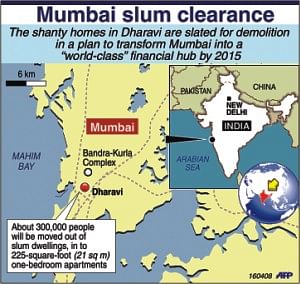Mumbai slum earmarked for oblivion

Map locating Dharavi in the Indian city of Mumbai
John James gestures from his rooftop terrace over the panoramic view he commands of Asia's largest slum -- a labyrinth of lanes crammed with shacks in India's financial capital of Mumbai.
"Do you believe they'd be interested in rehousing us if we weren't sitting on prime real estate?" asks James, 71, a retired steel contractor who arrived here 40 years ago and built his own business.
The first inhabitants of Dharavi, as the slum is known, are expected to be rehoused within the next two years, said Mukesh Mehta, the government-appointed architect in charge of the 2.3-billion-dollar project he calls a "pioneering effort" to bring people decent living conditions.
But opponents say they want to stay put until a redevelopment scheme is worked out that suits them -- and not just the developers who are planning to move in with a mix of public housing, luxury condos, offices and parks.
Maharashtra state officials plan to transform Mumbai, where 60 percent of the population of 18 million are slumdwellers, into a "world-class" financial hub by 2015.
To attain that goal, Dharavi -- and dozens of other shantytowns in the sprawling city -- must go.
Last month, a Forbes survey rated Mumbai the seventh filthiest city in the world.
"It's certain that this project will change Dharavi into a heaven, but we won't have a place in that heaven," said journalist Raju Korde, who writes for the leading local language newspaper the Marathi Times and is a resident of Dharavi.
Last May, newspaper advertisements were published in 20 countries offering developers "the opportunity of the millennium" to take part in the Dharavi project. Five developers from a shortlist of 19 are expected to be chosen within the next couple of months, Mehta told AFP.
Under the plan, 57,000 families or about 300,000 people will be moved into free but small -- 225-square-foot (21-square-metre) -- one-bedroom apartments in seven-storey blocks on the 551-acre (200-hectare) site surrounded by some of the world's costliest real estate.
"The developers will make a lot of money by developing Dharavi," Korde said. Mumbai used to be known as an industrial city, he said. "Nowadays it's a (financial) service city so Dharavi is not needed. They want to destroy the city's old face."
As Mumbai sits on a peninsula jutting into the sea, property prices rival those of London or New York.
Dharavi, once malarial swamp land on the city's edge, sits between two main suburban railway lines and in the shadow of the swanky Bandra-Kurla Complex, a new commercial centre, making it a very desirable location.
The plan calls for Dharavi to have 20 million square feet of new housing for Mumbai's well-heeled, 30 million square feet for the slum dwellers, and 20 million for commercial use such as offices and shopping malls.
"When people first settled here, it was marshland" next to the Mithi River where people caught fish to sell to city-dwellers, said James, who lives in a sturdy two-storey 1,500-square-foot house with his wife, an adult son, a daughter and her husband, and a grandson.
Later the area became a haven for poverty-stricken workers and penniless migrants who needed a cheap roof over their heads.
The project, in which developers will be compensated for building the free flats by constructing buildings to be sold at market rates, has been condemned by many residents who have created a self-sustaining economy.
Dharavi, a religious and cultural melting pot which every year draws thousands more migrants seeking to make their fortune, is a flourishing industrial centre.
"Seventy percent of the families are self-employed," said Jockin Arputham, head of the National Slum Dwellers Federation.
There are potteries, tanneries, garment workshops and other micro industries. The 15,000-odd cramped one-room factories and hundreds of cottage industries have an estimated total turnover of around half a bilion dollars a year, according to federal government figures.
The area is also famed for its thriving recycling industry in which workers break up computers, shred plastic, flatten cardboard and stack paper.
"How will I earn a living?" asked potter Hira Lal Rathod, gesturing to his 1,000-square-foot home where his four children live and he works. "To give us 225 square feet is not workable."
Architect Mehta says those running commercial operations can get extra space at a "concessional cost," but the price has not been disclosed.
"Why should we have to pay for space we already have now -- it doesn't make sense," said Rathod.
The Dharavi Bachao Andolan -- an all-party forum set up to fight for bigger houses -- is insisting that residents get free homes of between 400 and 800 square feet.
Government officials readily praise Dharavi as a model of in entrepreneurial initiative and say they aim to conserve that spirit.
But the tanneries and other workshops pollute Mumbai's already filthy waterways, they say, and the redevelopment, which includes environmentally friendly businesses, will ensure less pollution.
The slumdwellers will "get 225 square feet to live in -- many live in places much smaller. They won't have to line up for an outside toilet, they'll have their own bathroom with running water and electricity," said Mehta.
"There's no reason for them be unhappy," he said.
And of course some Dharavi residents agree.
Suresh Chaudhary, a balding taxi driver from northern Uttar Pradesh, has lived here for 15 years. He is squeezed into a second-storey room of just 150 square feet with his wife, 14-year-old daughter and mother. It is blisteringly hot during the summer and they have to line up for a communal toilet.

 For all latest news, follow The Daily Star's Google News channel.
For all latest news, follow The Daily Star's Google News channel. 



Comments